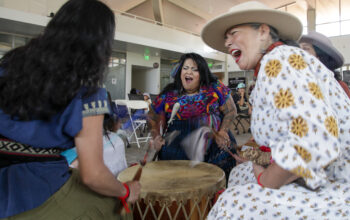More than 56 million people worldwide simultaneously dropped, covered, and held on to practice procedures in case of a natural disaster.
On Thursday Oct. 19, at 10:19 a.m., people nationwide experienced The Great Shakeout, an earthquake drill in which people practiced the “Drop, Cover, and Hold On” procedure.
The Great Shakeout is the world’s largest earthquake drill, and it has practiced since 2008, Los Angeles Community College District Safety and Emergency Services Manager William Ramirez said.
Ramirez said it began in California and expanded all over the country, and now it’s known and practiced around the world.
Although all LACCD schools are required to participate in the drill, Ramirez said the level of participation varies by school.
At Pierce, the district wanted to test its mass notification procedure. Registered students would receive a text at 10:19 a.m. letting them know that it’s time to “Drop, Cover, and Hold on” regardless of where they were.
According to Ramirez other schools practiced evacuating buildings.
“We are going to tell students that the buildings are stable and have students leave the buildings and meet at the safe zone locations. It would take 30 seconds to one minute maximum,” Ramirez said.
Pierce Professional Development Coordinator Shannon Krajewski informed students a day before the drill what the plan was for the campus during the drill.
“We are not going to actually evacuate people tomorrow because we are going to be doing that at a future date. And we want to make sure we are able to work with faculty to make sure that we are causing as little distraction to the students in their classes as possible,” Krajewski said.
A few days before the drill, Ramirez sent out an email to all LACCD faculty and staff. Krajewski said the purpose of the email was to let people know that the drill is happening statewide and remind them that “we live in earthquake country.”
“It’s more of an awareness than an actual physical drill. That is the purpose of the Great Shakeout annual event; it’s just to keep it in people’s minds,” Krajewski said.
Everything started with the California Resiliency Alliance, a partnership between Caltech and the Southern California Earthquake Center, Ramirez said.
“They came up with the idea statewide, but people were brought into it. It got bigger and bigger, and now it’s global,” Ramirez said.
“This year, we have 52.8 million people registered to participate. You can register online, but I already registered all of our students as a district,” Ramirez said.
The purpose was to do an exact count of how many students were going to participate.
Sophomore Jennifer Alvarado said it is important to have earthquake drills. She said in high school nobody gave the event much importance.
“If a real life emergency happened, we would not know what to do. Now that we are older, I think we would take the drills more seriously because everybody knows the big one is coming,” Alvarado said.
Alvarado said she is aware of the importance about having an emergency backpack at home and said that her immediate reaction to an earthquake would be to grab her dogs and go under the table.
“The longer we go between earthquakes, the more people forget because It’s been so long since we had a big one. People then start thinking it’s never gonna happen,” Krajewski said.
Pierce faculty and staff are working on preparing students for real life situations that can occur on campus at any time, Krajewski said.
“We have a lot of emergency things to make people aware of throughout the year. We are also talking about doing an active shooter drill, which would really just be how to do shelter-in-place wherever you are, in a classroom or the library. We are making plans for a lot of things,” Krajewski said.
Ramirez said he wants people to take action and prepare themselves at home, work, school, and anywhere else they can possibly be when an earthquake occurs.
“It is extremely important because it’s not a question of, if there’s going to be an earthquake, it’s a question of when, and we don’t know when. But we do know we are going to have more earthquakes,” Ramirez said.
Ramirez said it is important that students create a family emergency plan. Visit thegreatshakeout.org for more information and tips on how to prepare for a disaster.




